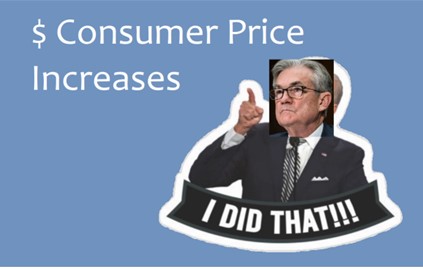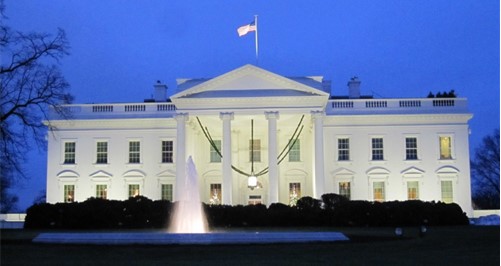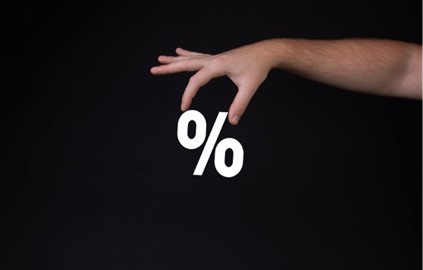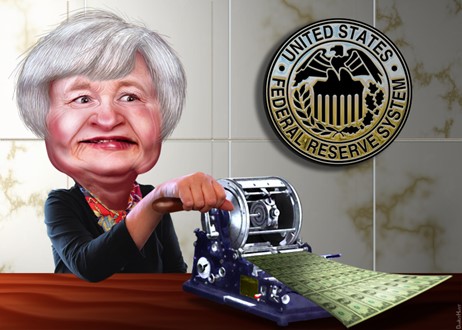Image Credit: Donkey Hotey (Flickr)
As the Treasury Matures Billions in Federal Reserve Holdings High Rates Could Squeeze the U.S. Budget
Have you ever taken out a 0% introductory rate credit card, ran up a bunch of charges on the low intro rate, and then had it reset to normal. It can be difficult to even keep up with interest payments, let alone chip away at the principal. Well, this is the situation the U.S. Treasury may find itself in as the Fed tightens from 0% at the beginning of 2022 to 3.50%, 4.50%, perhaps even higher before they find the terminal level that provides their desired 2% inflation target.
The seldom looked at dynamic of higher interest rates is that the U.S. Treasury is a huge borrower and that every basis point (0.01%) adds up. At the same time, the price of everything it purchases to run the country is subject to the same inflation dynamics gripping the rest of the world.
Since February 2020, already elevated national debt levels grew from $17 trillion to $24 trillion. Of this increase, $3.3 trillion would wind up owned by the Federal Reserve as part of their experimental
monetary policy. The U.S. Treasury positions owned by the Fed ballooned from $2.5 trillion in February 2020 to $5.8
trillion. Now Fed Chairman Powell is looking to cash in hundreds of billions of this debt to the U.S. Treasury without buying new issue debt.
The costs associated with this extra interest expense to the Treasury, without any additional benefit to citizens, may be felt in the form of a tighter national budget as interest costs grow and crowd out less immediate expenses. And interest costs do need to remain a priority; even the hint of default could drop the U.S. Government bond rating from S&P, Moody’s, or Fitch rating services. This would be devastating to the country’s overall ability to provide what we have come to expect as the basics. And it is something U.S. Treasury Secretary Janet Yellen would certainly not want to happen during her tenure.
The Part Q.T. Plays
Quantitative tightening (Q.T.) never fully got traction after the quantitative easing (Q.E.) that was implemented to deal with the 2008 financial crisis. As a reaction to fears of what the novel coronavirus might do to economic activity, a more aggressive, in size and format, Q.E. was put to work. In May, the Fed announced plans to begin to mop up all the extra money in the economy from bond purchases as part of past Q.E. strategies.
The announced plan is to reduce its Treasury holdings by $330 billion by the end of the year and by $720 billion annually until its balance sheet shrinks to a size deemed stabilizing at an inflation rate consistent with economic health. The Department of Treasury needs to give the Federal Reserve the loaned money back.
The Treasury has had the benefit of rolling higher interest rate maturing debt into lower interest rate bonds. This allowed them to increase their debt dramatically while federal interest costs barely increased despite the $7 trillion increase in Treasury debt. Using the 0% introductory credit card rate analogy, if a consumer moves $5,000 in debt from a 16.99% credit card to a 0% card, they can pile on almost $4,000 more in additional debt and still have a lower minimum payment. When the rate rises, a voluntary pullback has to be made by the consumer, as the interest servicing becomes a large budget expense.
Over the last three fiscal years ending on Sept. 30, 2021, the national gross interest cost was $573 billion, $523 billion, and $562 billion. These days are gone. Short-term rates have risen 1.5% following the Fed’s 75-basis-point rate hike in May and two smaller increases earlier this year. By the end of 2022, additional rate increases are expected to bring total rate increases to 3%, according to the Federal Reserve’s official guidance. The Fed projects short-term rates averaging 3.4% in December with a bias toward increasing next year.
As this additional 3% works its way into the refinancing of maturing Treasuries, federal interest costs will compound. There are about $3.7 trillion in outstanding Treasury bills, maturing in less than a year. Over 12 months, a 3% increase in rates would add to near $111 billion in additional annual interest expense on this outstanding debt.
There are $2.4 trillion Treasury notes (USTN) maturing within a year (notes are ten years and shorter, bonds are ten years and longer otherwise, there is no difference). The weighted average interest rate on these notes is 1.3%, and the weighted average original maturity is 4.7 years. So, to make the math easy, to replace it with a similar average maturity (current five-year Treasury note) the Treasury would incur a yield of about 2.91% (today’s five-year yield). And this is after a substantial rally last week. Rolling this maturing debt is expected to cost the Treasury near $85 billion in additional interest rate costs.
Total federal gross interest cost over the 12 months ending on May 31 was $666 billion. Looking at the above maturing Treasury debt over the next year, we can calculate the additional interest cost to be near $860 billion. This is a cost for which citizens receive nothing. By comparison, the Medicare system’s annual cost is $700 billion, and military spending over the past 12 months was $746 billion.
Take Away
There’s an item on the U.S. budget that will be skyrocketing. This is part of the price of fighting inflation. Paying the added cost could come from reduced spending (unlikely), increased taxes (not politically popular), or new debt (the usual solution).
The Federal Reserve’s plan to raise interest rates through Q.T. and raise overnight interest rate targets will bring the cost of government borrowing up. There are very few who will benefit from this.
One group that may are those that have been living on a fixed income and have depended on interest rate products like bonds, C.D.s, preferred stocks, and even dividend-paying common stocks for their income. This group has been on a tighter budget than they have expected for a long time, and some have given up hundreds of thousands in income since 2008. They are finally going to get paid again on their savings. Let’s all hope this serves as a kind of stimulus “check” for this large demographic that keeps the economy moving forward and providing opportunities.
Managing Editor, Channelchek
Suggested Content
 What Will It Take to End Rampant Home-Price Inflation?
|
 Powell is Told by President that He is the Face of Inflation
|
 Top Priority is Fighting Inflation, Says White House
|
 Investors Impacted by How Higher Interest Rates Will Impact the U.S. Treasury
|
Sources
Stay up to date. Follow us:

|
